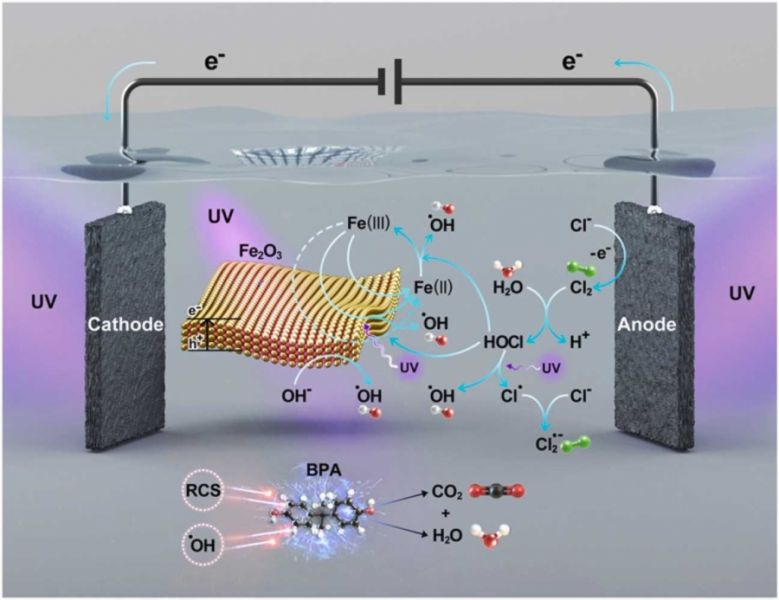循環農業:農業剩餘資材及生質衍生物高值化轉換再利用【環境工程學系/林坤儀特聘教授】
| 論文篇名 | 英文: Heterogeneous photocatalytic activation of electrogenerated chlorine for the production of reactive oxygen and chlorine species: A new approach for Bisphenol A degradation in saline wastewater 中文:多相光催化活化電生氯產生活性氧和氯物種:含鹽水中雙酚 A 降解的新方法 |
| 期刊名稱 | Journal of Hazardous Materials |
| 發表年份,卷數,起迄頁數 | 2023, 445, 130626 |
| 作者 | Yaghoot-Nezhad, Ali; Waclawek, Stanislaw; Madihi-Bidgoli, Soheila; Hassani, Aydin; Lin, Kun-Yi Andrew(林坤儀)*; Ghanbari, Farshid* |
| DOI | 10.1016/j.jhazmat.2022.130626 |
| 中文摘要 | UV-E-氯化/赤鐵礦奈米粒子(UV/E-Cl/HNs) 作為電生氯的非均相光催化活化,作為一種基於活性氯和氧物種生成的新方法,對雙酚A (BPA) 的降解進行了評估。 使用多種技術對製備的樣品進行表徵,例如 XRD、FTIR、FESEM、EDS 和 BET-BJH。 在最佳條件(pH 5、HNs用量100 mg/L、電流密度20 mA/cm2、NaCl濃度50 mM)下,電解40 min內即可達到99.4%的優異去污效率。 在紫外線 (UV) 照射和赤鐵礦存在下,HOCl 含量會更快降低,產生氧化自由基(即·OH、Cl· 和 Cl2·-)。 清除實驗也驗證了這些自由基在氧化處理中的重要角色。 UV/E-Cl/HNs 過程很容易透過多種機制提供羥基自由基。 碳酸氫根離子表現出明顯的抑製作用,而硝酸根和硫酸根陰離子僅對 BPA 降解產生輕微影響。 HNs 是一種可回收且穩定的催化劑,可循環六次。 此外,ECOSAR 計劃預測 UV/E-Cl/HN 可以被標記為環保製程。 最終,透過實驗和理論方法,根據確定的副產物提出了合理的降解途徑。 |
| 英文摘要 | UV-E-chlorination/hematite nanoparticles (UV/E-Cl/HNs) as a heterogeneous photocatalytic activation of electrogenerated chlorine was assessed for the degradation of bisphenol A (BPA) as a new approach based on the generation of reactive chlorine and oxygen species. The prepared sample was characterized using multiple techniques, such as XRD, FTIR, FESEM, EDS, and BET-BJH. An excellent decontamination efficiency of 99.4% was achieved within 40 min of electrolysis under optimum conditions (pH of 5, HNs dosage 100 mg/L, current density of 20 mA/cm2, and NaCl concentration of 50 mM). The HOCl content was reduced more swiftly in the presence of ultraviolet (UV) irradiation and hematite, resulting in the production of oxidative radicals (i.e., •OH, Cl•, and Cl2•-). The scavenging experiments also verified the vital role of these radicals in oxidative treatment. The UV/E-Cl/HNs process is readily supplied with hydroxyl radicals through several mechanisms. Bicarbonate ions showed a noticeable inhibitory impact, whereas nitrate and sulfate anions only slightly affected BPA degradation. The HNs were a recoverable and stable catalyst for six cycles. Furthermore, the ECOSAR program predicted that the UV/E-Cl/HNs can be labeled as an environmental-friendly process. Eventually, reasonable degradation pathways were proposed based on the identified by-products through experimental and theoretical approaches. |
| 發表成果與本中心研究主題相關性 | 透過本研究可進一步建立開發本研究計算所需之觸媒材料,並釐清可適合應用之環境條件! |







